Research on Dynamic Marine Atmospheric Corrosion Behavior of AZ31 Magnesium Alloy
Abstract
:1. Introduction
2. Materials and Methods
2.1. Material Preparation
2.2. Dynamic Natural Environment Exposure Test
2.3. Determination Method for Natural Environmental Factors
2.4. Corrosion Rate Measurements
2.5. Corrosion Products Analysis
2.6. Electrochemical Measurements
3. Results
3.1. The Environment of Field Exposure
| Environment Factor | T (°C) | RH (%) | Cl− (mg/m2d) | Wind Speed (m/s) |
|---|---|---|---|---|
| Range | −0.9~33.1 | 18~97 | 63.9~1130.0 | 0~20.2 |
| Average value | 21.1 | 75.4 | 232.4 | 5.2 |
| Environment Factor | T (°C) | RH (%) | Cl− (mg/m2d) | Wind Speed (m/s) |
|---|---|---|---|---|
| Range | −0.9~33.1 | 18~97 | 63.9~1130.0 | 0.2~20.2 |
| Average value | 26.0 | 75.7 | 380.4 | 6.8 |
| Location | Climate Type | Deposition Rate of Chloride (mg/m2d) |
|---|---|---|
| The Gulf of Mexico [24] | subtropical monsoon | 110~311 |
| Zhanjiang, coastal of China [25] | subtropical monsoon | 100~600 |
| Xisha Islands, China [22] | tropical marine climate | 64.39 |
| Qingdao, coastal of China [26] | temperate monsoon | 25 |
| Shimizu, coastal of Japan [21] | temperate monsoon | 4.2 |
3.2. Corrosion Rate
3.3. Surface Morphology Analysis
3.4. Corrosion Product Analysis
3.5. Electrochemical Behavior Analysis
4. Discussion
5. Conclusions
- The corrosion rate of AZ31 magnesium alloy after exposure for 1 year in dynamic marine atmospheric environment ocean voyage was 52.23 μm∙y−1, the maximum depth of corrosion pits was 276.366 μm, which is much higher than that of other research studied with static field exposure test at permanent location in marine environment. After exposure for 1 year, the main corrosion products were Mg5(CO3)4(OH)2·4H2O, MgCO3·3H2O and Mg2(OH)3Cl·4H2O. The corrosion was initiated from pitting corrosion and evolved into general corrosion.
- The dynamic marine atmospheric environment is hash, with high temperature, high relative humidity and high deposition rate of chloride. The average temperature was 26.0 °C. The relative humidity was 75.7%, the proportion of time when RH > 75% was 56%. The average deposition rate of chloride ion was 380.4 mg/m2d.
- The synergistic effect of high relative humidity and chloride ion plays an important role in the corrosion process of AZ31 magnesium alloy. During ocean voyage, the AZ31 magnesium alloy was covered by thin electrolyte layer of high concentration of chloride ion in most of time, which accelerated the corrosion of AZ31 magnesium alloy significantly.
Author Contributions
Funding
Institutional Review Board Statement
Informed Consent Statement
Data Availability Statement
Acknowledgments
Conflicts of Interest
References
- Huo, P.; Li, F.; Wu, R.; Gao, R.; Zhang, A.X. Annealing coordinates the deformation of shear band to improve the microstructure difference and simultaneously promote the strength-plasticity of composite plate. Mater. Des. 2022, 219, 110696. [Google Scholar] [CrossRef]
- Zou, J.; Ma, L.; Jia, W.; Le, Q.; Qin, G.; Yuan, Y. Microstructural and mechanical response of ZK60 magnesium alloy subjected to radial forging. J. Mater. Sci. Technol. 2021, 83, 228–238. [Google Scholar] [CrossRef]
- Kumar, S.D.; Kumar, S.S. Effect of heat treatment conditions on ballistic behaviour of various zones of friction stir welded magnesium alloy joints. Trans. Nonferrous Met. Soc. China 2021, 31, 156–166. [Google Scholar] [CrossRef]
- Fu, B.; Shen, J.; Suhuddin, U.F.H.R.; Pereira, A.A.C.; Maawad, E.; Santos dos, J.F.; Klusemann, B.; Rethmeier, M. Revealing joining mechanism in refill friction stir spot welding of AZ31 magnesium alloy to galvanized DP600 steel. Mater. Des. 2021, 209, 109997. [Google Scholar] [CrossRef]
- Wang, D.; Liu, S.; Wu, R.; Zhang, S.; Wang, Y.; Wu, H.; Zhang, J.; Hou, L. Synergistically improved damping, elastic modulus and mechanical properties of rolled Mg-8Li-4Y-2Er-2Zn-0.6Zr alloy with twins and long-period stacking ordered phase. J. Alloys Compd. 2021, 881, 160663. [Google Scholar] [CrossRef]
- Ma, C.; Liu, Y.; Zhou, H.; Jiang, Z.; Ren, W.; He, F. Influencing mechanism of mineral admixtures on rheological properties of fresh magnesium phosphate cement. Constr. Build. Mater. 2021, 288, 123130. [Google Scholar] [CrossRef]
- Jin, S.; Ma, X.; Wu, R.; Li, T.; Wang, J.; Krit, B.L.; Hou, L.; Zhang, J.; Wang, G. Effect of carbonate additive on the microstructure and corrosion resistance of plasma electrolytic oxidation coating on Mg–9Li–3Al alloy. Int. J. Miner. Metall. Mater. 2022, 29, 1453–1463. [Google Scholar] [CrossRef]
- Esmaily, M.; Svensson, J.E.; Fajardo, S.; Birbilis, N.; Frankel, G.S.; Virtanen, S.; Arrabal, R.; Thomas, S.; Johansson, L.G. Fundamentals and advances in magnesium alloy corrosion. Prog. Mater. Sci. 2017, 89, 92–193. [Google Scholar] [CrossRef]
- Esmaily, M.; Shahabi-Navid, M.; Svensson, J.-E.; Halvarsson, M.; Nyborg, L.; Cao, Y.; Johansson, L.-G. Influence of temperature on the atmospheric corrosion of the Mg-Al alloy AM50. Corros. Sci. 2015, 90, 420–433. [Google Scholar] [CrossRef] [Green Version]
- Merino, M.C.; Pardo, A.; Arrabal, R.; Merino, S.; Casajús, P.; Mohedano, M. Influence of chloride ion concentration and temperature on the corrosion of Mg–Al alloys in salt fog. Corros. Sci. 2010, 52, 1696–1704. [Google Scholar] [CrossRef]
- Lebozec, N.; Jönsson, M.; Thierry, D. Atmospheric Corrosion of Magnesium Alloys: Influence of Temperature, Relative Humidity, and Chloride Deposition. Corrision 2004, 60, 356–361. [Google Scholar] [CrossRef] [Green Version]
- Jönsson, M.; Dan, P.; Thierry, D. Corrosion product formation during NaCl induced atmospheric corrosion of magnesium alloy AZ91D. Corros. Sci. 2007, 49, 1540–1558. [Google Scholar] [CrossRef]
- Ma, X.; Jin, S.; Wu, R.; Wang, J.; Wang, G.; Krit, B.; Betsofen, S. Corrosion behavior of Mg−Li alloys: A review. Trans. Nonferrous Met. Soc. China 2021, 31, 3228–3254. [Google Scholar] [CrossRef]
- Wan, H.; Cai, Y.; Song, D.; Li, T. Investigation of corrosion behavior of Mg-6Gd-3Y-0.4Zr alloy in Xisha atmospheric simulation solution. Ocean Eng. 2020, 195, 106760. [Google Scholar] [CrossRef]
- Jönsson, M.; Persson, D. The influence of the microstructure on the atmospheric corrosion behaviour of magnesium alloys AZ91D and AM50. Corros. Sci. 2010, 52, 1077–1085. [Google Scholar] [CrossRef]
- Nie, L.; Zhao, X.; Liu, P.; Hu, L.; Zhang, J.; Hu, J.; Wu, F.; Cao, F. Electrochemical behavior of ZE41 magnesium alloy under simulated atmospheric corrosion. Int. J. Electrochem. Sci. 2019, 14, 3095–3113. [Google Scholar] [CrossRef]
- Feliu, S., Jr.; Pardo, A.; Merino, M.C.; Coy, A.E.; Viejo, F.; Arrabal, R. Correlation between the surface chemistry and the atmospheric corrosion of AZ31, AZ80 and AZ91D magnesium alloys. Appl. Surf. Sci. 2009, 255, 4102–4108. [Google Scholar] [CrossRef] [Green Version]
- Lindström, R.W.; Svensson, J.-E.; Johansson, L.G. The influence of carbon dioxide on the atmospheric corrosion of some magnesium alloys in the presence of NaCl. J. Electrochem. Soc. 2002, 149, B103–B107. [Google Scholar] [CrossRef]
- Feliu, S., Jr.; Maffiotte, C.; Galván, J.C.; Barranco, V. Atmospheric corrosion of magnesium alloys AZ31 and AZ61 under continuous condensation conditions. Corros. Sci. 2011, 53, 1865–1872. [Google Scholar] [CrossRef] [Green Version]
- Jönsson, M.; Persson, D.; Leygraf, C. Atmospheric corrosion of field-exposed magnesium alloy AZ91D. Corros. Sci. 2008, 50, 1406–1413. [Google Scholar] [CrossRef]
- Liao, J.; Hotta, M.; Motoda, S.; Shinohara, T. Atmospheric corrosion of two field-exposed AZ31B magnesium alloys with different grain size. Corros. Sci. 2013, 71, 53–61. [Google Scholar] [CrossRef]
- Cui, Z.; Li, X.; Xiao, K.; Dong, C. Atmospheric corrosion of field-exposed AZ31 magnesium in a tropical marine environment. Corros. Sci. 2013, 76, 243–256. [Google Scholar] [CrossRef]
- Man, C.; Dong, C.; Wang, L.; Kong, D.; Li, X. Long-term corrosion kinetics and mechanism of magnesium alloy AZ31 exposed to a dry tropical desert environment. Corros. Sci. 2020, 163, 108274. [Google Scholar] [CrossRef]
- Soares, G.C.; Garbatov, Y.; Zayed, A.; Wang, G. Influence of environmental factors on corrosion of ship structures in marine atmosphere. Corros. Sci. 2009, 51, 2014–2016. [Google Scholar] [CrossRef]
- Chen, H.; Cui, H.; He, Z.; Lu, L.; Huang, Y. Influence of chloride deposition rate on rust layer protectiveness and corrosion severity of mild steel in tropical coastal atmosphere. Mater. Chem. Phys. 2021, 259, 123971. [Google Scholar] [CrossRef]
- Sun, X.; Lin, P.; Man, C.; Cui, J.; Wang, H.; Dong, C.; Li, X. Prediction model for atmospheric corrosion of 7005-T4 aluminum alloy in industrial and marine environments. Int. J. Miner. Metall. Mater. 2018, 25, 1313–1319. [Google Scholar] [CrossRef]
- Lindström, R.; Johansson, L.; Thompson, G.E.; Skeldon, P.; Svensson, J. Corrosion of magnesium in humid air. Corros. Sci. 2004, 46, 1141–1158. [Google Scholar] [CrossRef]
- Niklasson, A.; Johansson, L.; Svensson, J. The influence of relative humidity and temperature on the acetic acid vapour-induced atmospheric corrosion of lead. Corros. Sci. 2008, 50, 3031–3037. [Google Scholar] [CrossRef]
- Nazir, M.H.; Saeed, A.; Khan, Z. A comprehensive predictive corrosion model incorporating varying environmental gas pollutants applied to wider steel applications. Mater. Chem. Phys. 2017, 193, 19–34. [Google Scholar] [CrossRef]
- Kumar, P.; Pathak, S.; Singh, A.; Jain, K.; Khanduri, H.; Wang, L.; Kim, S.K.; Pant, R.P. Observation of intrinsic fluorescence in cobalt ferrite magnetic nanoparticles by Mn2+ substitution and tuning the spin dynamics by cation distribution. J. Mater. Chem. C 2022, 10, 12652–12679. [Google Scholar] [CrossRef]
- Pang, H.; Tian, P.; Wang, J.; Wang, X.; Ning, G.; Lin, Y. Fabrication of microstructured Mg5(CO3)4(OH)2 4H2O and MgCO3 in flue gas absorption technology. Mater. Lett. 2014, 131, 206–209. [Google Scholar] [CrossRef]
- Wang, Y.; Li, Z.; Demopoulos, G.P. Controlled precipitation of nesquehonite (MgCO3·3H2O) by the reaction of MgCl2 with (NH4)2CO3. J. Cryst. Growth 2008, 310, 1220–1227. [Google Scholar] [CrossRef]
- Lojka, M.; Jiříčková, A.; Lauermannová, A.M.; Pavlíková, M.; Pavlík, Z.; Jankovský, O. Kinetics of formation and thermal stability of Mg2(OH)3Cl·4H2O. AIP Conf. Proc. 2019, 2170, 020009. [Google Scholar]
- Kim, S.H.; Yeon, S.; Lee, J.H.; Kim, Y.W.; Lee, H.; Park, J.; Lee, N.; Choi, J.P.; Aranas, C., Jr.; Lee, Y.J.; et al. Additive manufacturing of a shift block via laser powder bed fusion: The simultaneous utilisation of optimised topology and a lattice structure. Virtual Phys. Prototyping 2020, 15, 460–480. [Google Scholar] [CrossRef]
- Zhang, Z.; Fedortchouk, Y.; Hanley, J.J.; Kerr, M. Diamond resorption and immiscibility of C-O-H fluid in kimberlites: Evidence from experiments in H2O—CO2— SiO2—MgO—CaO system at 1–3 GPa. Lithos 2021, 380–381, 105858. [Google Scholar] [CrossRef]
- Sun, L.; Dong, N.; Wang, J.; Ma, H.; Jin, P.; Peng, Y. Effect of solid solution Zn atoms on corrosion behaviors of Mg-2Nd-2Zn alloys. Corros. Sci. 2022, 196, 110023. [Google Scholar] [CrossRef]


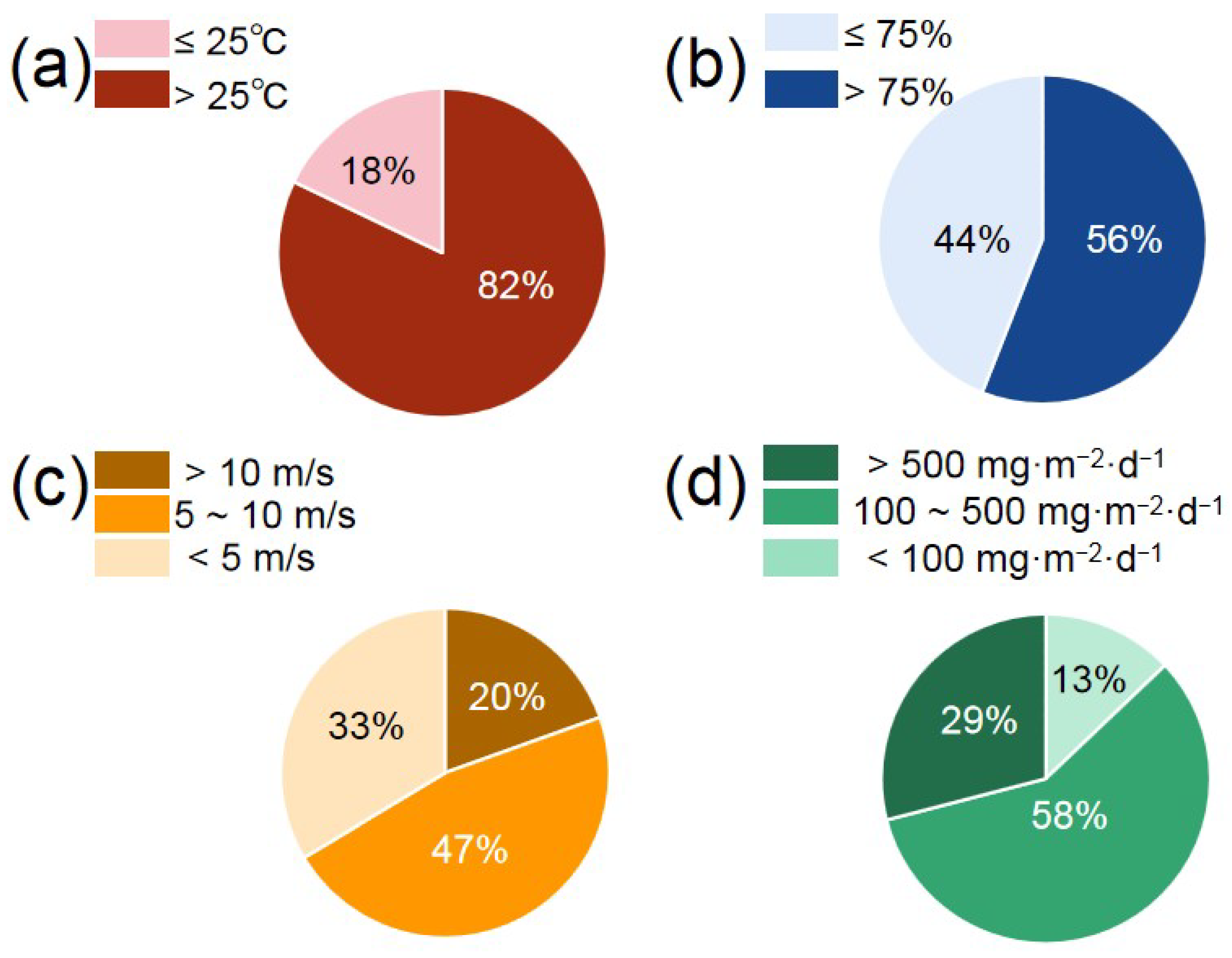
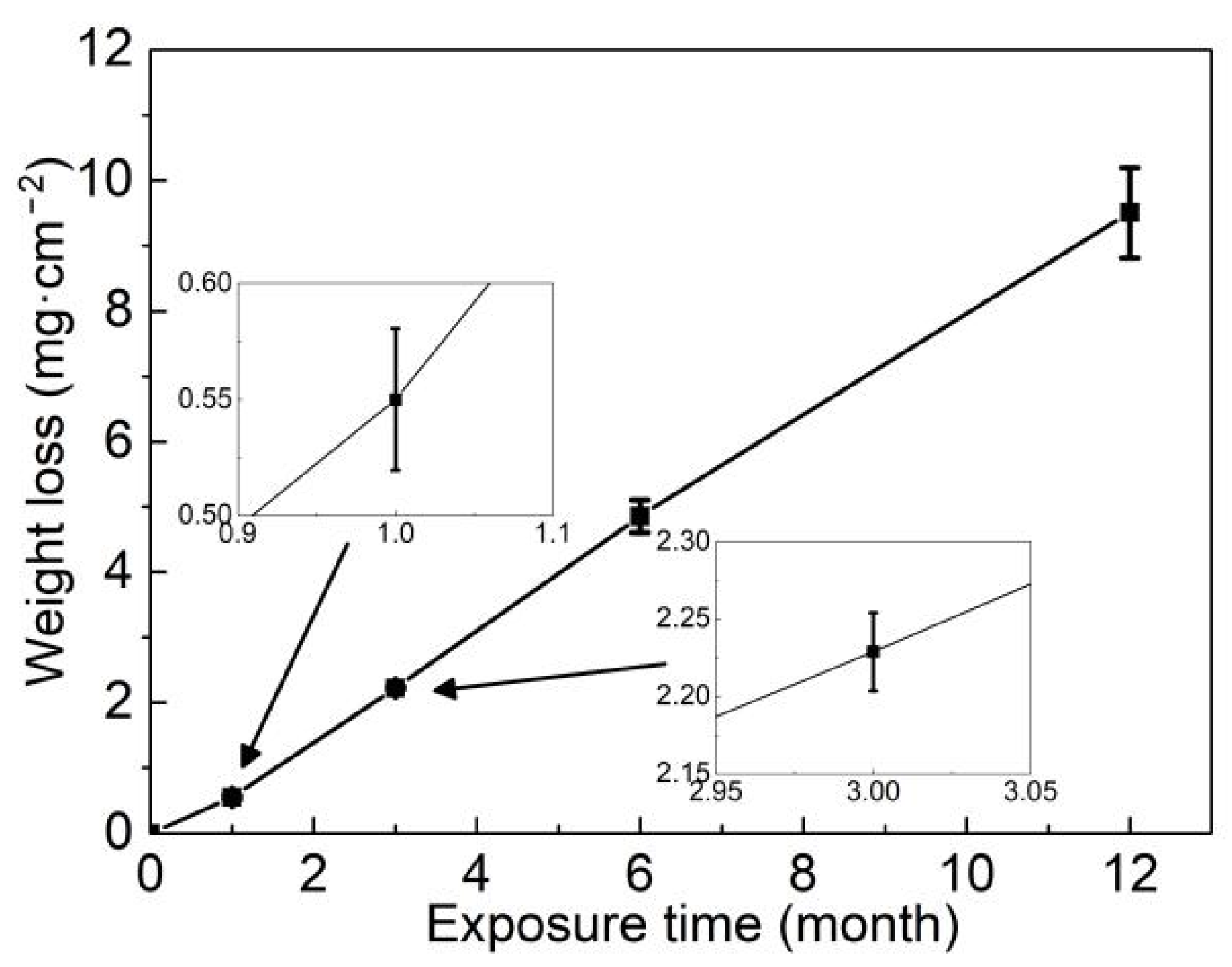
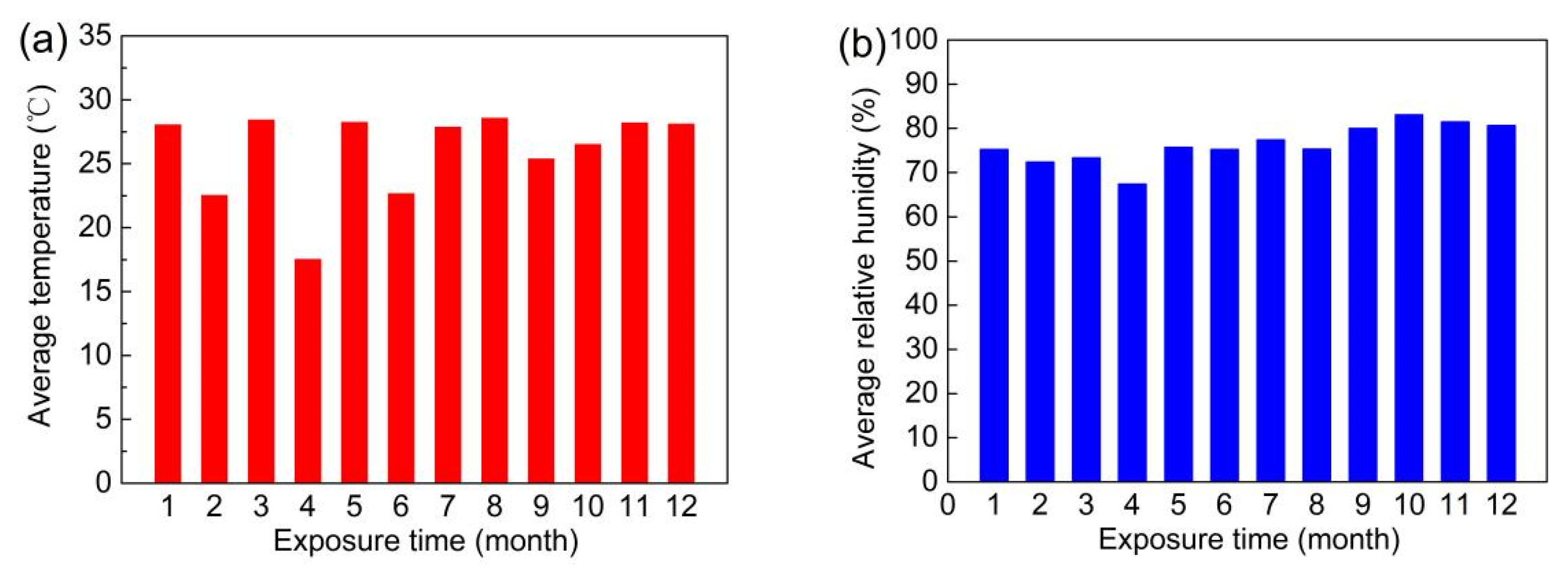

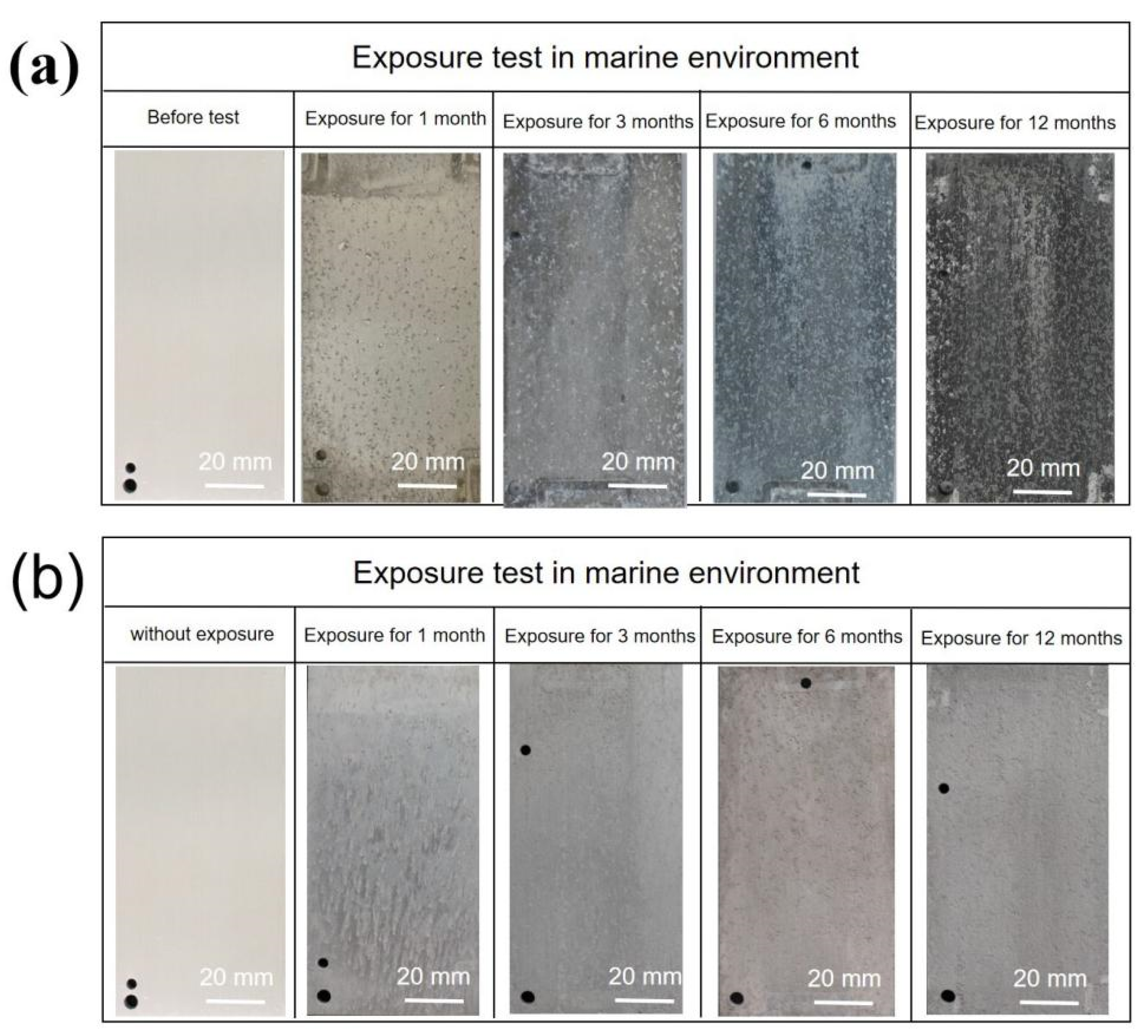


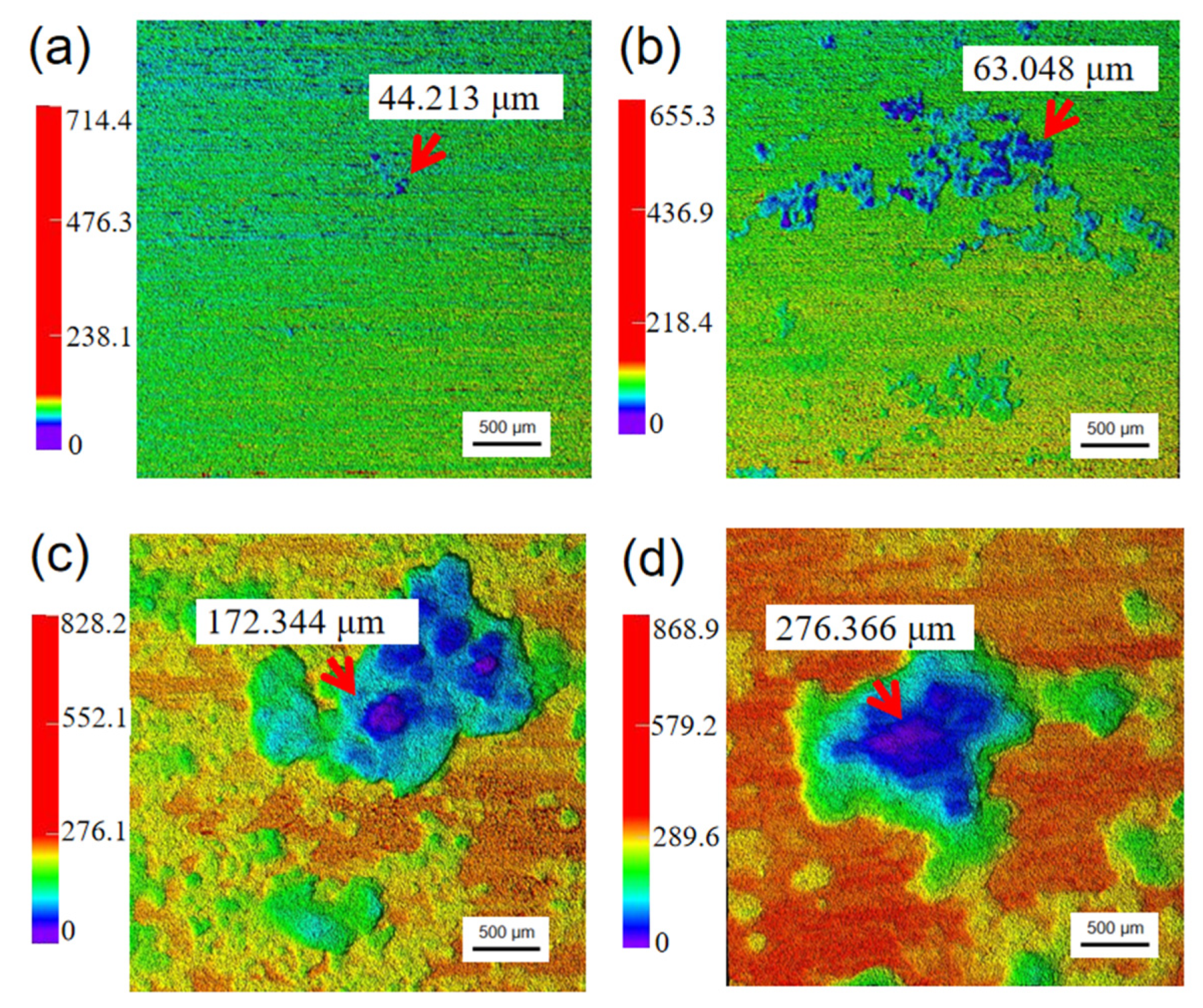
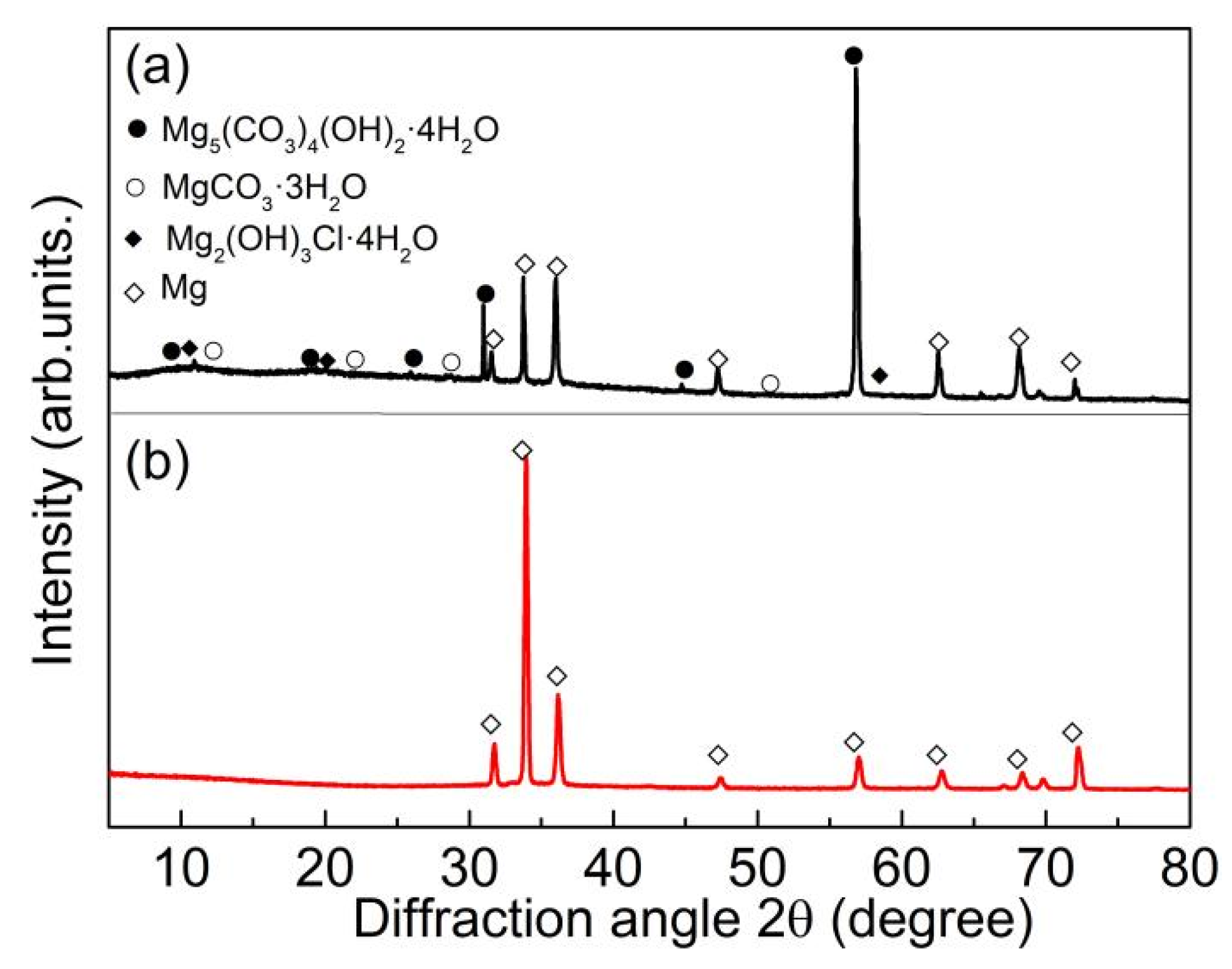
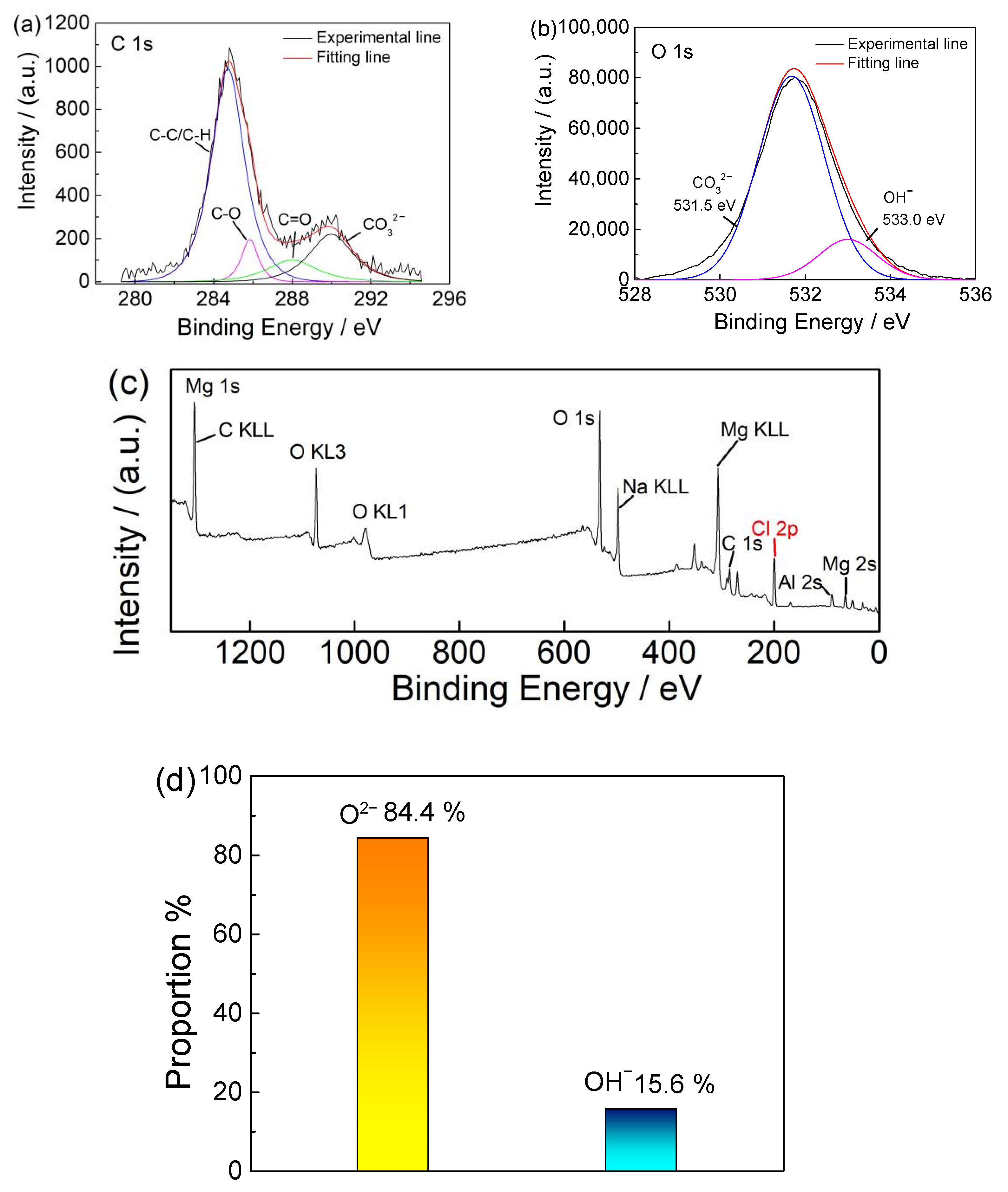
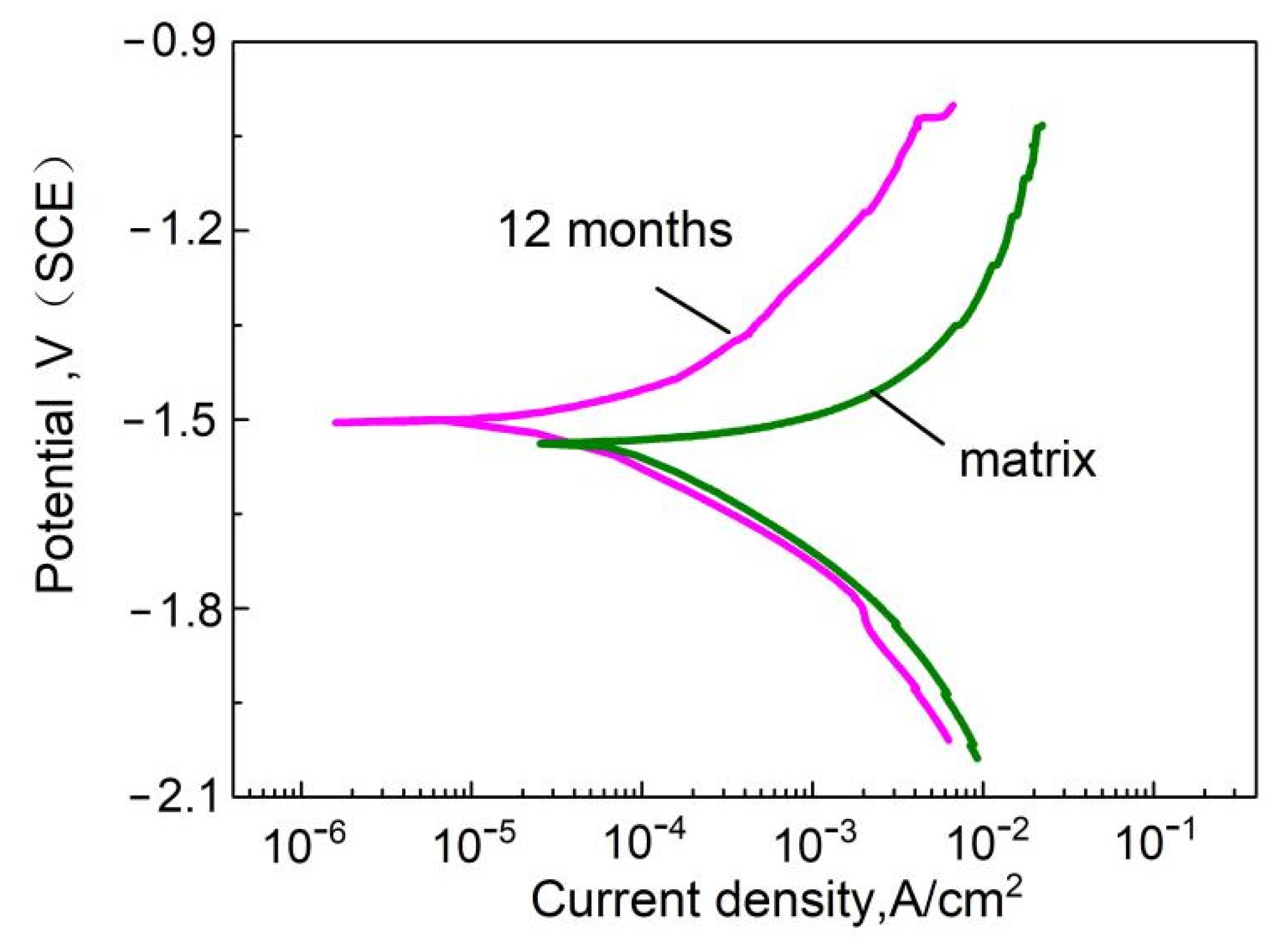
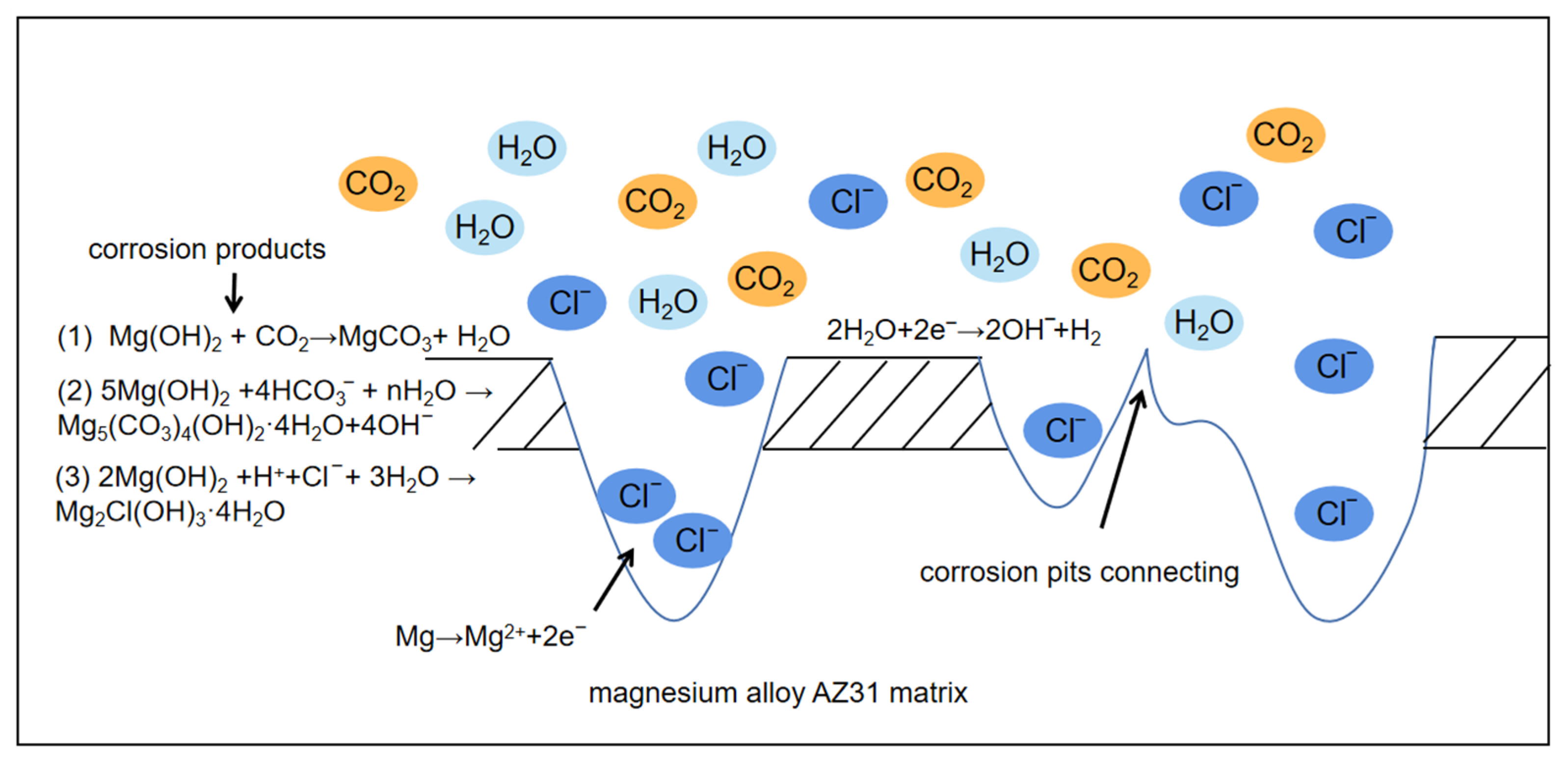
| Material | Al | Zn | Mn | Si | Fe | Cu | Ni | Mg |
|---|---|---|---|---|---|---|---|---|
| AZ31 | 3.19 | 0.81 | 0.30 | 0.025 | 0.006 | 0.002 | 0.0006 | Bal. |
| Element | S 2p | Cl 2p | C 1s | O 1s | Mg 2p | Zn 2p |
|---|---|---|---|---|---|---|
| Atomic % | 1.99 | 12.69 | 29.6 | 41.71 | 13.7 | 0.3 |
| Specimens | Potential (Ecorr /V) | Corrosion Current Density (icorr /Acm−2) |
|---|---|---|
| Matrix | −1.532 | 1.054 × 10−4 |
| 12 months | −1.508 | 2.984 × 10−5 |
Publisher’s Note: MDPI stays neutral with regard to jurisdictional claims in published maps and institutional affiliations. |
© 2022 by the authors. Licensee MDPI, Basel, Switzerland. This article is an open access article distributed under the terms and conditions of the Creative Commons Attribution (CC BY) license (https://creativecommons.org/licenses/by/4.0/).
Share and Cite
Wang, Y.; Xu, W.; Wang, X.; Jiang, Q.; Li, Y.; Huang, Y.; Yang, L. Research on Dynamic Marine Atmospheric Corrosion Behavior of AZ31 Magnesium Alloy. Metals 2022, 12, 1886. https://doi.org/10.3390/met12111886
Wang Y, Xu W, Wang X, Jiang Q, Li Y, Huang Y, Yang L. Research on Dynamic Marine Atmospheric Corrosion Behavior of AZ31 Magnesium Alloy. Metals. 2022; 12(11):1886. https://doi.org/10.3390/met12111886
Chicago/Turabian StyleWang, Ying, Weichen Xu, Xiutong Wang, Quantong Jiang, Yantao Li, Yanliang Huang, and Lihui Yang. 2022. "Research on Dynamic Marine Atmospheric Corrosion Behavior of AZ31 Magnesium Alloy" Metals 12, no. 11: 1886. https://doi.org/10.3390/met12111886
APA StyleWang, Y., Xu, W., Wang, X., Jiang, Q., Li, Y., Huang, Y., & Yang, L. (2022). Research on Dynamic Marine Atmospheric Corrosion Behavior of AZ31 Magnesium Alloy. Metals, 12(11), 1886. https://doi.org/10.3390/met12111886







